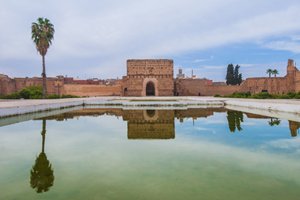
Nestled in North Africa, Morocco is a country that never fails to captivate the imagination with its vibrant culture, gorgeous landscapes, and rich history. From the bustling markets of Marrakech to the tranquillity of the Sahara Desert, Morocco offers a unique blend of ancient traditions and modern influences. Here are 10 intriguing facts that might surprise you about this enchanting destination.
Morocco's culture is a rich tapestry woven from Berber, Arab, and European influences. Its strategic location at the crossroads of Africa, Europe, and the Middle East has made it a melting pot of diverse traditions and customs. From the colourful attire of the Berber tribes to the intricate architecture of the mosques, every corner of Morocco reflects this cultural fusion.
Tucked away in the Rif Mountains, Chefchaouen is often referred to as the "Blue City" due to its distinctive blue-washed buildings. Legend
has it that the tradition of painting the buildings blue was introduced by Jewish refugees in the 1930s, who believed that the colour blue would symbolise the sky and remind them of God.
Morocco is home to a significant portion of the Sahara Desert, the largest hot desert in the world. The vast expanse of golden sand dunes, known as Erg Chebbi and Erg Chigaga, offers a surreal landscape that attracts adventurers from around the globe. Visitors can experience the magic of the desert by embarking on a camel trek or spending a night under the starry sky in a traditional Berber camp.
The medina of Fes is not only one of the largest in Morocco but also the oldest continuously functioning medieval city in the world. With its labyrinthine streets, bustling souks, and exquisite architecture, Fes offers a glimpse into Morocco's rich history and heritage. Visitors can explore ancient madrasas, historic mosques, and vibrant tanneries tucked away within the maze-like alleys of the medina.
Moroccan cuisine is a feast for the senses, characterised by its bold flavours and aromatic spices. From hearty tagines and fluffy couscous to sweet pastries and refreshing mint tea, Moroccan cuisine reflects the country's diverse cultural influences. Don't miss the opportunity to sample traditional dishes like couscous royale, pastilla, and harira soup during your visit.
Morocco's stunning landscapes and exotic ambiance have made it a popular filming location for Hollywood movies and television series. Iconic films such as "Lawrence of Arabia" and "Gladiator" were partially shot in Morocco, thanks to its diverse scenery that ranges from snow-capped mountains to sun-kissed deserts.
Morocco boasts an impressive array of Islamic architecture, with intricate designs and exquisite craftsmanship adorning mosques, palaces, and mausoleums across the country. The Hassan II Mosque in Casablanca is not only one of the largest mosques in the world but also a masterpiece of modern Islamic architecture, featuring intricate mosaics, marble floors, and a towering minaret that overlooks the Atlantic Ocean.
Beyond its desert landscapes, Morocco is also home to the majestic Atlas Mountains, which stretch over 1,600 miles across the country. The High Atlas region offers unparalleled opportunities for outdoor adventure, including hiking, trekking, and skiing during the winter months. Visitors can explore picturesque villages nestled amidst terraced valleys and towering peaks, providing a glimpse into traditional Berber life.
Morocco boasts an impressive collection of UNESCO World Heritage Sites, ranging from ancient Roman ruins to well-preserved medieval medinas. The historic city of Marrakech, with its iconic Djemaa el-Fna square and labyrinthine souks, is a UNESCO World Heritage Site that attracts millions of visitors each year. Other notable sites include the Roman ruins of Volubilis, the fortified city of Ait Benhaddou, and the historic medina of Essaouira.
Moroccan hospitality is legendary, with locals known for their warm welcome and generous spirit. Tea plays a central role in Moroccan culture, serving as a symbol of hospitality and friendship. Traditional mint tea, known as "atay," is served throughout the day and often accompanied by sweet pastries or savoury snacks. Visitors are encouraged to partake in this timeless ritual and savour the flavours of Moroccan hospitality.